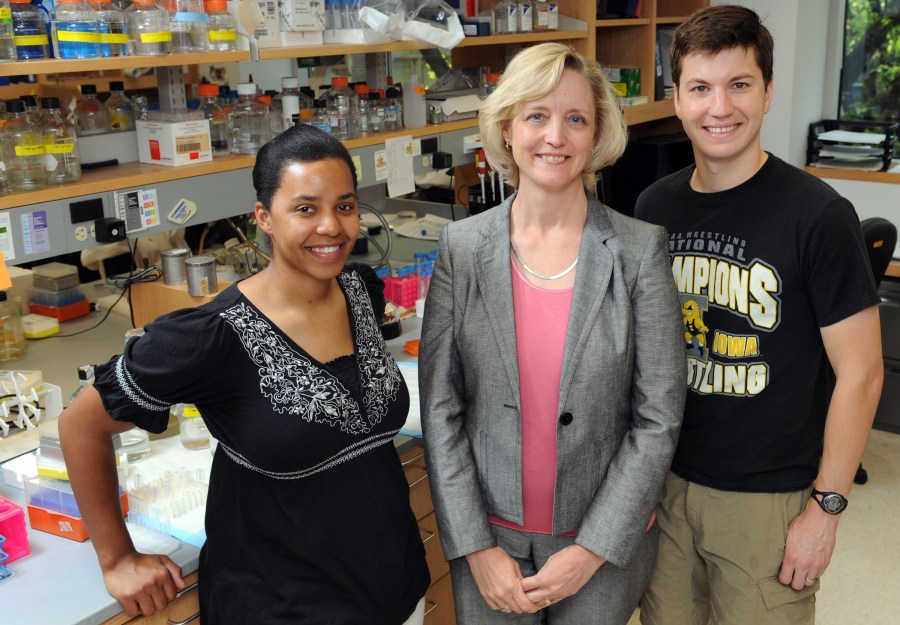
Susan Wente, Ph.D., center, with study team members Kristen Noble and Andrew Folkmann. (photo by Joe Howell)
Cell’s life in the hands of a DEAD-box protein
If one thinks of DNA – stored in the nucleus – as the “master blueprint” for building functional cells, then the RNA copy of each gene can be considered the “instruction sheet” for each individual job.
Many RNAs, after being carefully copied from the DNA, must move out into the cell cytoplasm to serve their intended function. Messenger RNAs (mRNAs), for example, must be exported to the cytoplasm to direct the formation of specific proteins. This export process – critical to the life of all cells – occurs through a channel called the nuclear pore complex (NPC).
Vanderbilt University Medical Center investigators have been deciphering the roles of the molecular players that shuttle mRNA out of the cell nucleus through the NPC. Now, in collaboration with a team at Dartmouth Medical School, they report a more complete picture of mRNA export.
Their findings, published in two papers in Genes & Development and featured on the journal cover, also suggest a new paradigm for the activity of DEAD-box proteins, a family of proteins that impact the fates of RNAs throughout the cell.

“DEAD-box proteins are involved in all aspects of cellular function, yet very little is known about how they’re regulated,” said Susan Wente, Ph.D., associate vice chancellor for Research.
These proteins have been linked to cancer and are targets of viruses like hepatitis C, HIV and poxviruses, which “pirate” DEAD-box protein pathways for their own purposes.
“The potential impact on cellular physiology and pathology is very broad,” Wente said. “It’s a wide open field to begin to understand how DEAD-box proteins are regulated normally, and how they might be dysregulated in disease.”
Wente’s group has focused on the DEAD-box protein Dbp5, which participates in mRNA export from the nucleus.
Export of mRNAs through the NPC goes something like this: newly made mRNAs associate with various proteins in the nucleus, this mRNA-protein complex travels out through the NPC, and then it is released at the cytoplasmic side of the pore. At this step, the mRNA complex is prepared for its next adventure through a “remodeling” step where some proteins are removed and new ones are added.
Dbp5 participates in this remodeling step, and Wente’s group previously demonstrated that the protein Gle1 and the small molecule IP6 together activate this Dbp5 function by stimulating it to break down the molecule ATP into ADP plus energy.
In the new studies, Kristen Noble, a Meharry-Vanderbilt Alliance M.D./Ph.D. student who is doing her dissertation research in Wente’s laboratory, further showed that Gle1 and IP6 actually stimulate ATP loading onto Dbp5, as well as its breakdown.
Even more exciting, said Wente, Noble discovered that another protein (Nup159) acts as an “ADP release factor” for Dbp5. After Dbp5 has broken ATP into ADP, and remodeled the mRNA complex, Nup159 helps it to “let go” of the ADP. Without Nup159 action, Dbp5 can’t keep cycling to aid mRNA export, and mRNAs accumulate inside the nucleus.
Nup159 is the first ADP release factor that has been identified for a DEAD-box protein, and Wente and her team believe it may represent a general paradigm for regulating DEAD-box family members.
“We’ve been trying to figure out how these machines do their work – how they trigger the remodeling, how the cycles of activity are controlled,” Wente said. “We had defined individual steps, but now we have the full cycle, the whole picture.”
The investigators have observed a high degree of functional conservation in this biological system and believe the mechanisms they’ve identified in yeast cells (which have 25 DEAD-box family members) also hold true in human cells (which have more than 38 DEAD-box proteins). Andrew Folkmann, a graduate student in Wente’s laboratory, characterized the Dbp5 cycle in human cells, and is now studying the effects of knocking down Dpb5 and other proteins with roles in mRNA export in human cells.
Charles Cole, Ph.D., leads the Dartmouth group that has a longstanding collaboration with Wente. The research was supported by the National Institutes of Health.













